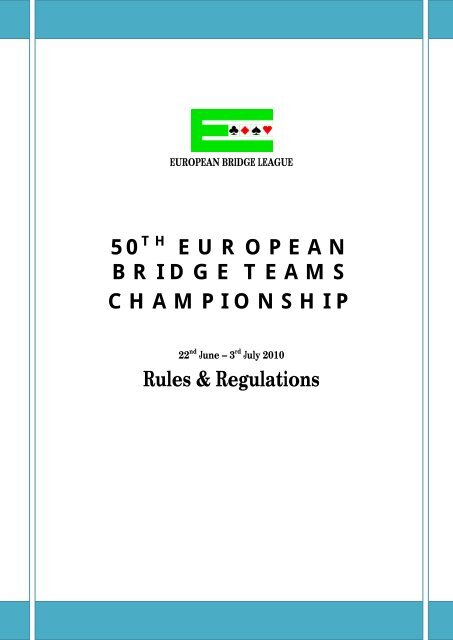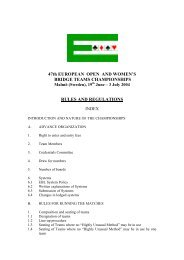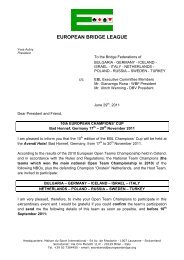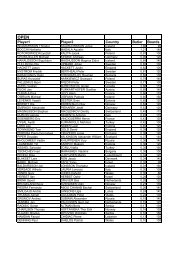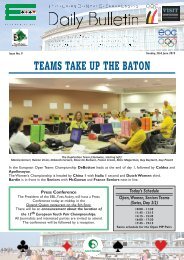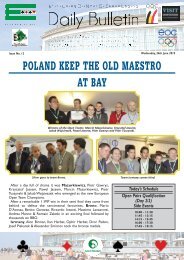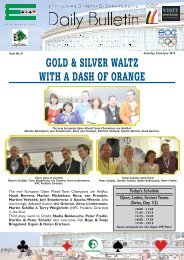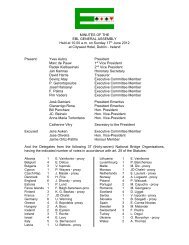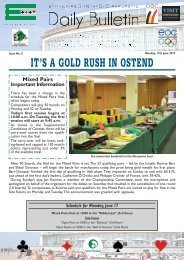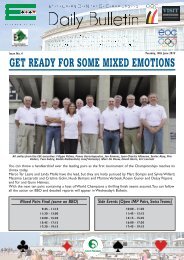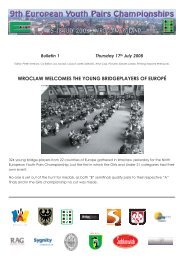Rules & Regulations - European Bridge League
Rules & Regulations - European Bridge League
Rules & Regulations - European Bridge League
Create successful ePaper yourself
Turn your PDF publications into a flip-book with our unique Google optimized e-Paper software.
EUROPEAN BRIDGE LEAGUE<br />
50 th EUROPEAN<br />
BRIDGE TEAMS<br />
CHAMPIONSHIP<br />
22 nd June – 3 rd July 2010<br />
<strong>Rules</strong> & <strong>Regulations</strong>
Table of Contents<br />
A. INTRODUCTION, NATURE AND TIMETABLE OF THE CHAMPIONSHIPS ................................................................. 4<br />
A.1 Introduction ...................................................................................................................................................... 4<br />
A.2 Nature ............................................................................................................................................................... 4<br />
A.3 Timetable .......................................................................................................................................................... 4<br />
B. ADVANCE ORGANIZATION .................................................................................................................................. 5<br />
B.1 Registration....................................................................................................................................................... 5<br />
B.1.1 Registration of Teams ...................................................................................................................................................... 5<br />
B.1.2 Registration of Players’ Names ........................................................................................................................................ 5<br />
B.2 Right to enter, and entry fees ........................................................................................................................... 5<br />
B.3 Team Members ................................................................................................................................................. 5<br />
B.4 Credentials Committee ..................................................................................................................................... 5<br />
B.5 Draw for numbers ............................................................................................................................................. 6<br />
B.6 Systems ............................................................................................................................................................. 6<br />
B.6.1 Systems Policy .................................................................................................................................................................. 6<br />
B.6.2 Written explanations of systems ..................................................................................................................................... 6<br />
B.6.3 Submission of Systems (in all series) ................................................................................................................................ 6<br />
B.6.4 Changes in lodged systems .............................................................................................................................................. 7<br />
C. RULES FOR RUNNING THE MATCHES .................................................................................................................. 7<br />
C.1 Composition and seating of teams ................................................................................................................... 7<br />
C.1.1 Designation of teams ....................................................................................................................................................... 7<br />
C.1.2 Line-up procedure............................................................................................................................................................ 7<br />
C.1.3 Seating of Teams where no ‘Highly Unusual Method’ may be in use. ............................................................................. 7<br />
C.1.4 Seating of Teams where a ‘Highly Unusual Method’ may be in use by one team. ........................................................... 7<br />
C.1.5 Seating of Teams where ‘Highly Unusual Methods’ may be used by both teams ............................................................ 7<br />
C.1.6 Seating of Teams where “Brown Stickers” may be in use ................................................................................................ 7<br />
C.1.7 Substitutes ....................................................................................................................................................................... 8<br />
C.2 Time procedure and penalties for slow play. .................................................................................................... 8<br />
C.2.1 Start of the round ............................................................................................................................................................ 8<br />
C.2.2 End of the period of play. ................................................................................................................................................ 8<br />
C.2.3 Penalty warning ............................................................................................................................................................... 9<br />
C.3 General rules during play .................................................................................................................................. 9<br />
C.3.1 Language .......................................................................................................................................................................... 9<br />
C.3.2 Dealing ............................................................................................................................................................................. 9<br />
C.3.3 Duplication and movement of boards ............................................................................................................................. 9<br />
C.3.4 Non-playing players ....................................................................................................................................................... 10<br />
C.3.5 Finish of play .................................................................................................................................................................. 10<br />
C.3.6 Leaving the table and playing rooms ............................................................................................................................. 10<br />
C.3.7 Authorised persons in the playing rooms ...................................................................................................................... 10<br />
C.3.8 Scoring at the table ........................................................................................................................................................ 11<br />
C.3.9 Recording the matches .................................................................................................................................................. 11<br />
C.3.10 Use of the systems ......................................................................................................................................................... 11<br />
C.4 End of rounds, results ..................................................................................................................................... 11<br />
C.4.1 IMP scale ........................................................................................................................................................................ 11<br />
C.4.2 VP scale .......................................................................................................................................................................... 11<br />
C.4.3 Effect of penalty points .................................................................................................................................................. 12<br />
C.4.4 Protest time ................................................................................................................................................................... 12<br />
C.4.5 Carry-over (Open Series) ................................................................................................................................................ 12<br />
C.4.6 The Draw ........................................................................................................................................................................ 12<br />
C.4.7 Official results ................................................................................................................................................................ 13<br />
C.4.8 Publication of decisions ................................................................................................................................................. 13<br />
C.5 Byes, Ranking and Ties .................................................................................................................................... 13<br />
C.5.1 Byes ............................................................................................................................................................................... 13<br />
C.5.2 Ranking .......................................................................................................................................................................... 13<br />
C.5.3 Ties ................................................................................................................................................................................. 13<br />
D. REGULATIONS SUPPLEMENTING THE LAWS ...................................................................................................... 13<br />
D.1 Bidding Boxes, Screens, <strong>Bridge</strong>mates and International Code ....................................................................... 13<br />
D.1.1 Bidding Boxes ................................................................................................................................................................. 13<br />
D.1.2 Screens........................................................................................................................................................................... 14<br />
D.1.3 <strong>Bridge</strong>mates ................................................................................................................................................................... 15<br />
D.1.4 International Code ......................................................................................................................................................... 15<br />
EBL <strong>Rules</strong> & <strong>Regulations</strong>, Ostend 2010<br />
Page 2 of 22
E. ETHICS .............................................................................................................................................................. 16<br />
E.1 Player’s Obligations ........................................................................................................................................ 16<br />
E.2 Looking at partner .......................................................................................................................................... 16<br />
E.3 Discussions ...................................................................................................................................................... 16<br />
E.4 Partnership understandings............................................................................................................................ 16<br />
F. NON-PLAYING CAPTAINS .................................................................................................................................. 16<br />
F.1 Rights of a non-playing captain ....................................................................................................................... 16<br />
F.2 Conversation at the table ............................................................................................................................... 17<br />
F.3 Substitute captains ......................................................................................................................................... 17<br />
G. VIEWGRAPH & BROADCASTED MATCHES ......................................................................................................... 17<br />
G.1 Obligation to play ........................................................................................................................................... 17<br />
G.2 Access to Viewgraph Room ............................................................................................................................ 17<br />
G.3 Playing time .................................................................................................................................................... 17<br />
H. APPEALS AND APPEALS COMMITTEE ................................................................................................................ 17<br />
H.1 Appeals ........................................................................................................................................................... 17<br />
H.1.1 Procedure ...................................................................................................................................................................... 17<br />
H.1.2 Practices in the Appeals Committee .............................................................................................................................. 18<br />
H.2 Appeals Committee ........................................................................................................................................ 18<br />
H.2.1 Composition of the Appeals Committee ........................................................................................................................ 18<br />
H.2.2 Investigations ................................................................................................................................................................. 19<br />
H.2.3 Judgment ....................................................................................................................................................................... 19<br />
I. JOURNALISTS AND SPECTATORS ....................................................................................................................... 19<br />
I.1 Journalists ....................................................................................................................................................... 19<br />
I.2 Spectators ....................................................................................................................................................... 19<br />
J. TOURNAMENT DIRECTORS ............................................................................................................................... 20<br />
J.1 General duties of Tournament Directors ........................................................................................................ 20<br />
K. NON-SMOKING, ALCOHOL AND MOBILE PHONES ............................................................................................. 20<br />
K.1 Non-Smoking .................................................................................................................................................. 20<br />
K.2 Alcohol ............................................................................................................................................................ 20<br />
K.3 Mobile phones and electronic devices ........................................................................................................... 20<br />
L. DRESS CODE ..................................................................................................................................................... 21<br />
L.1 Formal Occasions ............................................................................................................................................ 21<br />
L.2 Playing rooms ................................................................................................................................................. 21<br />
L.3 Publicity .......................................................................................................................................................... 21<br />
M. ANTI-DOPING REGULATIONS ............................................................................................................................ 21<br />
N. SECURITY .......................................................................................................................................................... 21<br />
O. REGISTRATION AND PUBLICATION .................................................................................................................... 21<br />
P. AWARDS ........................................................................................................................................................... 22<br />
Q. CHANGES TO REGULATIONS ............................................................................................................................. 22<br />
EBL <strong>Rules</strong> & <strong>Regulations</strong>, Ostend 2010<br />
Page 3 of 22
A. INTRODUCTION, NATURE AND TIMETABLE OF THE CHAMPIONSHIPS<br />
A.1 Introduction<br />
The 50 th <strong>European</strong> <strong>Bridge</strong> Teams Championship ("the Championship") is to be played under the<br />
auspices of the <strong>European</strong> <strong>Bridge</strong> <strong>League</strong> ("the EBL") in Ostend, Belgium commencing on Tuesday<br />
22 nd June 2010 and ending not later than Saturday 3 rd July 2010. The Championship consist of 3<br />
Series: Open Series, Women Series and Senior Series.<br />
A.2 Nature<br />
The Open Series consists of two complete round-robins. In the first round-robin the teams are<br />
divided into two groups according to the ranking of the preceding 3 <strong>European</strong> <strong>Bridge</strong> Teams<br />
Championship (Malmö 2004, Warsaw 2006, Pau 2008). At the end of the first round- robin the 9<br />
best ranked teams from each group are qualified for the second round robin. The other teams<br />
finish the championship at that stage. It is anticipated that matches will be of 20 boards. Each<br />
team qualified for the second (final) round robin will carry forward 100% of the IMPs and VPs<br />
achieved against the other 8 qualified teams from the first round robin and will play a 20 board<br />
match against each of the 9 teams from the other group.<br />
The Women’s Series consists of a complete round-robin with all teams playing each other. It is<br />
anticipated that matches will be of 20 boards.<br />
The Senior Series will consist of a complete round-robin if the number of participating countries is<br />
sufficient. It is anticipated that matches will be of 16 or 20 boards, depending on the number of<br />
matches played in this championship.<br />
The results of the matches are expressed in victory points and at the completion of the roundrobin<br />
the teams will be ranked according to the numbers of Victory Points gained<br />
The Championship is played under the Laws of <strong>Bridge</strong> 2007 and the present <strong>Rules</strong> and<br />
<strong>Regulations</strong>, whose special provisions for this Championship supplement those Laws.<br />
A.3 Timetable<br />
Opening Ceremony Tuesday 22nd June<br />
• Open Teams 1 st Round-Robin Wednesday 23 rd – Wednesday 30 th June<br />
• Open Teams Final Round-Robin Wednesday 30 th June – Saturday 3 rd July<br />
• Women Teams Wednesday 23 rd June – Saturday 3 rd July<br />
• Senior Teams Welcome Friday 25 th June<br />
• Senior Teams Saturday 26 th June – Saturday 3 rd July<br />
• Closing Ceremony Saturday 3 rd July<br />
EBL <strong>Rules</strong> & <strong>Regulations</strong>, Ostend 2010<br />
Page 4 of 22
B. ADVANCE ORGANIZATION<br />
B.1 Registration<br />
B.1.1 Registration of Teams<br />
All entries to the Championships tournaments must be submitted electronically, via the EBL<br />
website (not by email) at http://www.eurobridge.org/competitions/10Ostend/Information.htm<br />
by 1 st April 2010. It is very important that this deadline is respected.<br />
B.1.2 Registration of Players’ Names<br />
Registration of members of the teams and NBO Delegation members’ names must be submitted<br />
electronically, via the EBL website (not by email) at<br />
http://www.eurobridge.org/competitions/10Ostend/Information.htm<br />
by 15 th April 2010. It is very important that this deadline is respected.<br />
B.2 Right to enter, and entry fees<br />
Each member country, being up to date with the payment of its dues (including the 2010 dues) to<br />
the EBL is authorised to enter one team in the Open Series, one team in the Women’s Series and<br />
one team in the Senior Series of the Championship. Countries must have paid the entry fee and<br />
be up to date with the payment of dues to the EBL before they can participate in the<br />
Championship.<br />
The entry fees are € 3,500 for the Open and Women’s Teams and € 3,250 for the Senior Teams. A<br />
discount will be given to countries who did not participate in the last three EBL <strong>Bridge</strong> Teams<br />
Championships (held in Malmö 2004, Warsaw 2006 and Pau 2008): for these teams the entry fees<br />
are € 2,500 both for the Open and Women and € 2,000 for the Senior Teams.<br />
A discount of € 500 will also be given to countries who will accommodate all their players at the<br />
Thermae Palace Hotel or make their reservation through the Ostend Tourist Office and arrange<br />
accommodation for all their players in the hotels recommended.<br />
The entry fees must be paid by Bank Transfer before or on 15th April 2010 to<br />
BANQUE PARIBAS (Suisse)<br />
2, Place de Hollande, CH-1211 Geneva 11 – Suisse<br />
Account EUROPEAN BRIDGE LEAGUE Number 3097300<br />
(IBAN) CH 46 0868 6309 7300 04978 – (SWIFT) BPPBCHGG (to be mentioned)<br />
No team will be permitted to refuse to play against any other team and such refusal to play will<br />
result in disqualification.<br />
B.3 Team Members<br />
In addition to a non-playing captain and a coach or team-manager, each team is entitled to have<br />
six members. Subject to the approval of the Credentials Committee the members of any team<br />
may be changed up to the time of commencement of play of the Championship.<br />
If a country has submitted the names of fewer than six players, a fifth or sixth player may be<br />
added after the commencement of play but only during the first day and only with permission of<br />
the Appeals Committee.<br />
B.4 Credentials Committee<br />
The names of the captain, coach and the other members of each team as well as the names of<br />
Chief Delegation, Team Manager, Medical Doctor, Journalists and members of the NBO’s Official<br />
Delegation must be sent for approval to the EBL President via the EBL website (not by e-mail) at<br />
http://www.eurobridge.org/competitions/10Ostend/Information.htm<br />
by 15 th April 2008.<br />
EBL <strong>Rules</strong> & <strong>Regulations</strong>, Ostend 2010<br />
Page 5 of 22
Every proposed player must, along with other criteria, satisfy the Credentials Committee that:<br />
a) he/she is nominated by the NBO of the country of his/her birth or the NBO of which<br />
such nominated player first became a member, and has not, during the current or<br />
immediately preceding two calendar years, represented a different NBO in any WBF<br />
competition or any zonal or intra-zonal competition; or<br />
b) he/she is nominated by the NBO of the country of his citizenship or bona fide residence<br />
and has not, during the current or immediately preceding two calendar years,<br />
represented a different NBO in any WBF competition or any zonal or intra-zonal<br />
competition<br />
c) for the Senior Series he/she was born before the 1 st January 1951.<br />
In any case only accredited people can enter the venue of the Championship.<br />
B.5 Draw for numbers<br />
Prior to play an official draw for numbers in the schedule of play will be made and will be<br />
published in the programme. In the event of a variation in the number of teams participating,<br />
adjustments in the draw and schedule of play may occur. These will be notified in the<br />
programme, or if necessary at the captains’ meeting.<br />
B.6 Systems<br />
B.6.1 Systems Policy<br />
a) The <strong>European</strong> <strong>Bridge</strong> <strong>League</strong>’s Systems <strong>Regulations</strong> and Systems Policy 2007 ("the<br />
SYSTEMS POLICY") apply to these Championships. Category 1 systems and conventions<br />
are permitted in the Open and Women’s Series. Only Category 3 systems and<br />
conventions are permitted in the Senior Series.<br />
b) Both members of a partnership must adopt the same methods in the auction and in<br />
their carding.<br />
B.6.2 Written explanations of systems<br />
Every participating partnership in the Championships must complete, accurately and legibly, an<br />
EBL Convention Card (with supplementary sheets as appropriate) in accordance with "the<br />
SYSTEMS POLICY" and the Systems <strong>Regulations</strong> published separately to the NBOs and included on<br />
the EBL Website at www.eurobridge.org and on www.ecatsbridge.com.<br />
A partnership may lodge a comprehensive statement of its methods (which may be of any length<br />
but must be in English) prior to the commencement of the Championship at the Systems Desk for<br />
the attention of the Appeals Committee. Any statement so lodged may be used by the Director<br />
and the Appeals Committee (and may be used by the partnership in argument before the Appeals<br />
Committee) to assist in determining whether or not full, proper and timely information was given<br />
to the opponents as to the meaning of calls made in the auction by the partnership and of any<br />
related partnership understanding.<br />
No prior agreement is permitted by which a varied meaning of a call or play applies only after a<br />
question asked, a reply given, or an irregularity occurring<br />
B.6.3 Submission of Systems (in all series)<br />
Systems in all the series have to be registered with the <strong>European</strong> <strong>Bridge</strong> <strong>League</strong> by 10 th May 2010<br />
by email to: anna@ecats.co.uk<br />
Strict compliance with Section 1.2 of the Systems <strong>Regulations</strong> is required.<br />
Copies of opponents’ filed Systems will be made available by e-mail and on the Internet to all<br />
teams who have filed their Systems.<br />
EBL <strong>Rules</strong> & <strong>Regulations</strong>, Ostend 2010<br />
Page 6 of 22
Failure to lodge Systems as required by this rule may result in prohibition of a System. In addition<br />
the Appeals Committee may impose a financial penalty of up to € 340 for the late filing of<br />
Systems.<br />
B.6.4 Changes in lodged systems<br />
Team captains must give careful attention to the requirements in Section 1.6 of the Systems<br />
<strong>Regulations</strong>.<br />
C. RULES FOR RUNNING THE MATCHES<br />
C.1 Composition and seating of teams<br />
C.1.1 Designation of teams<br />
The team mentioned first in the schedule of matches printed in the programme is designated as<br />
the Home Team. Its opponent is the Away Team.<br />
C.1.2 Line-up procedure<br />
Since teams meet each other only once there will be no seating rights when teams without<br />
‘Highly Unusual Methods’ play each other. Both captains submit their line up without knowing<br />
the line-up of their opponents. The line-up will be made by computer.<br />
Line-ups for a round have to be submitted within 15 minutes after the previous round has ended.<br />
For the first round the details will be announced at the captains’ meeting.<br />
Teams who infringe this regulation may be subject to VP penalties according to this scale:<br />
1st occasion a written warning<br />
2nd occasion ½ VP penalty<br />
Subsequently 1 VP penalty for each occasion.<br />
C.1.3 Seating of Teams where no ‘Highly Unusual Method’ may be in use.<br />
Where neither team contains any partnership that uses a ‘Highly Unusual Method’ the following<br />
seating arrangements shall apply:<br />
The teams meet according to the schedule printed in the programme. The Home Team sits<br />
throughout in the N/S position in the Open Room and in the E/W position in the Closed Room.<br />
C.1.4 Seating of Teams where a ‘Highly Unusual Method’ may be in use by one<br />
team.<br />
Where one team contains any partnership that uses a ‘Highly Unusual Method’ the following<br />
seating arrangements shall apply:<br />
The team that does not contain any partnership that uses a ‘Highly Unusual Method’, will always<br />
be the Home Team and gets seating rights. It gets an additional 5 minutes to submit the line-up<br />
knowing the line-up of its opponent. Furthermore a pair playing a ‘Highly Unusual Method’ has an<br />
obligation to be seated at the playing table 15 minutes before the start of the round when<br />
requested by their opponents. Notification of the request shall be given at the line-up desk when<br />
submitting the line-up.<br />
C.1.5 Seating of Teams where ‘Highly Unusual Methods’ may be used by both teams<br />
The line-up procedure and seating arrangements are as set out in C.1.2, C.1.3 and C.1.4 above.<br />
Pairs playing ‘Highly Unusual Methods’ from both teams need to be seated 15 minutes in advance<br />
if either opponent so require.<br />
C.1.6 Seating of Teams where “Brown Stickers” may be in use<br />
When a team contains any partnership that uses more than 1 brown sticker all the above<br />
mentioned rules adopted for HUM Systems will be applied.<br />
EBL <strong>Rules</strong> & <strong>Regulations</strong>, Ostend 2010<br />
Page 7 of 22
C.1.7 Substitutes<br />
If for whatever reason a team is unable to produce four players, the Head Tournament Director is<br />
empowered to designate a substitute to complete the team. A substitute so designated need not<br />
be a national of the country in whose team he or she substitutes. A substitute cannot be a player<br />
of another team. A substitute in the Women’s Series must be female. A substitute in the Senior<br />
Series must be a Senior B.3 section c). The decision as to whether the result shall stand of a match<br />
in which a substitute has played for some or all of the boards, and what, if any, penalties shall be<br />
imposed, shall rest with the Appeals Committee, which will adjudicate upon every instance in<br />
which a substitute plays.<br />
The Head Tournament Director, having designated a substitute, shall inform a member of the<br />
Appeals Committee on duty as soon as possible and furnish the Appeals Committee with a<br />
written report.<br />
C.2 Time procedure and penalties for slow play.<br />
C.2.1 Start of the round<br />
At the beginning of each round the Tournament Director on duty will announce the time by which<br />
the round must be completed. For a sixteen board match this will be 2 hours and 20 minutes and<br />
for a twenty board match this will be 2 hours and 50 minutes.<br />
The period allowed is calculated from the commencement of the period of play and includes the<br />
time for system explanation and scoring procedure. Play in the Open Room between two<br />
opposing teams may start only when the players of the same teams are seated in the Closed<br />
Room. Any team that is not seated and ready to play at the start of a period of play will be fined 1<br />
VP and for each completed period of 5 minutes thereafter a further 1VP. Players are requested to<br />
be seated 5 minutes before the scheduled start of play. Any team not seated within half an hour<br />
after starting time by its own fault forfeits the match and receives zero Victory Points For the<br />
score of the opposing team see C.5.2.<br />
If any team has been fined for being late at the commencement of a round the fines for slow play<br />
in the same round will be based on the time at which all players were seated at the table and<br />
ready to play.<br />
C.2.2 End of the period of play.<br />
a) If at the end of the allocated time play has not been completed fines will be imposed as<br />
follows:<br />
from 0 to 5 minutes late: a fine of 1 VP will be imposed on the table and<br />
shared 0.5 VP to each team if they are considered to bear equal responsibility<br />
for overrunning.<br />
from 5 to 10 minutes late: 2 VPs imposed on the table, shared likewise equally<br />
1 VP each<br />
from 10 to 15 minutes late: 4 VPs likewise<br />
from 15 to 20 minutes late: 6 VPs likewise<br />
from 20 to 25 minutes late: 10 VPs likewise.<br />
for delays of more than 25 minutes the Appeals Committee may impose a<br />
more severe penalty.<br />
b) If a pair should claim that the responsibility for the slow play is with their opponents,<br />
they will do so by calling the Tournament Director who will take any corrective<br />
measures that are necessary in his opinion, including, at his discretion, the designation<br />
of a monitor at the table for as long as he considers desirable.<br />
EBL <strong>Rules</strong> & <strong>Regulations</strong>, Ostend 2010<br />
Page 8 of 22
The Tournament Director will normally issue warnings when teams are in danger of<br />
penalties for slow play, but an absence of warning does not diminish the responsibility<br />
of the players or their liability to be fined.<br />
If the two sides at the table are not considered to bear equal responsibility for the late<br />
finish the prescribed penalty in (a) will be divided between the two teams<br />
proportionately to the extent to which each side is deemed to have contributed to the<br />
overrun.<br />
c) It is a serious breach of propriety deliberately to break a Law or Rule even if one is<br />
willing to accept the prescribed penalty. Accordingly, over and above the prescribed<br />
penalties, the Tournament Director may impose an additional penalty in cases where<br />
he is of the opinion that players are indulging deliberately in unnecessarily slow play.<br />
The following regulations will be observed in putting this rule into effect:<br />
i) No such penalty will be awarded unless the Tournament Director has given<br />
previous verbal warning to the players concerned of his intention to invoke this<br />
rule.<br />
ii) Such a penalty may be imposed only in respect of continued delay in the same<br />
session of play as that in which a verbal warning has been given.<br />
iii) The penalty may, in the discretion of the Tournament Director, be imposed on<br />
one only or on both of the teams involved in the match in which such a delay<br />
occurs, or, at his discretion, a larger penalty may be imposed on one team than<br />
upon the other to reflect the measure of each team’s responsibility for the<br />
occurrence.<br />
C.2.3 Penalty warning<br />
Except for a penalty under C.2.2.c above all penalties for violations of time procedure and slow<br />
play are mandatory and require no previous warning to the players that penalties will be applied.<br />
C.3 General rules during play<br />
C.3.1 Language<br />
All players are reminded that the official language of the Championships is English and during a<br />
match the players are expected to converse in this language only unless both teams agree to<br />
speak another language.<br />
C.3.2 Dealing<br />
The boards will have been pre-dealt and duplicated.<br />
C.3.3 Duplication and movement of boards<br />
a) Wherever possible, boards will be duplicated more than once so that boards are not<br />
transferred from the Open Room to the Closed Room or vice-versa.<br />
b) When it is not possible for the boards to be duplicated the following provisions will<br />
apply:<br />
i) The tables will be numbered in a logical manner so that it is easy to identify<br />
corresponding tables in the Open and Closed Rooms. Similarly the boards will be<br />
clearly labelled so that they correspond to a particular pair of tables (one in the<br />
Open Room and one in the Closed Room).<br />
ii) The North and East players at every table are required, at the beginning of each<br />
match, to complete curtain cards by writing the names of their respective<br />
countries thereon, and then to place such curtain card in the pocket of the first<br />
board played corresponding to his position.<br />
EBL <strong>Rules</strong> & <strong>Regulations</strong>, Ostend 2010<br />
Page 9 of 22
In due course the boards will be passed by the board movers between the Open and the Closed<br />
Rooms.<br />
The players are required to check that the boards given to them by the board movers are the<br />
correct boards, and that they are played in the correct polarity.<br />
To do this:<br />
i) The players should check that the boards bear labels which correspond to the<br />
table at which they are playing<br />
ii) North and East should check the curtain card completed by their respective<br />
opponents in the same seats in the other room.<br />
C.3.4 Non-playing players<br />
Non-playing players of a team are not allowed to watch their team-mates playing (except in the<br />
Viewgraph theatre).<br />
C.3.5 Finish of play<br />
At each table when play has finished the players should agree the scores and then leave the<br />
Room (Open or Closed) as quickly as possible.<br />
C.3.6 Leaving the table and playing rooms<br />
No player may leave the table during a match unless authorized by the Tournament Director. If<br />
any player leaves the table during a match without permission of the Tournament Director, that<br />
player’s team will be fined 2 VPs.<br />
No player may leave the playing rooms during a match unless accompanied by a person<br />
designated by the Tournament Director. If any player leaves the playing room during a match<br />
without permission of the Tournament Director, that player’s team will be fined 2 VPs.<br />
No recorder - see C.3.9 b) below - may leave the table during a match unless authorized by the<br />
Tournament Director. If a recorder leaves the table during a match without permission of the<br />
Tournament Director the team responsible for the recorder may be fined 2 VPs.<br />
No recorder - see C.3.9 b) below - may leave the playing room during a match unless<br />
accompanied by a person designated by the Tournament Director. If a recorder leaves the playing<br />
room during a match without permission of the Tournament Director the team responsible for<br />
the recorder may be fined 2 VPs.<br />
C.3.7 Authorised persons in the playing rooms<br />
Authorised persons who may enter the playing rooms (except by special permission of the<br />
Chairman of the Tournament Committee) are: --<br />
the staff on duty<br />
the Chairman of the Appeals Committee and the members of the Appeals<br />
Committee on duty<br />
the President of the E.B.L.<br />
the Chairman of the Tournament Committee<br />
the captains or coaches (or their respective duly approved designates) are<br />
allowed in the Open Room, except the Open Vugraph room, where they are<br />
not allowed. In the Closed Room the captain of the Away Team or his<br />
designated is allowed but only for the purpose of recording; see C.3.9 b)<br />
below.<br />
except in the Open VG room, where they are not allowed, two duly accredited<br />
journalists plus one representative of the Bulletin, all of whom must remain<br />
for the entire round in the rooms. Each of them must watch at only one table..<br />
EBL <strong>Rules</strong> & <strong>Regulations</strong>, Ostend 2010<br />
Page 10 of 22
Hotel staff for the provision of refreshments.<br />
C.3.8 Scoring at the table<br />
Scoring at the table is done by the use of the <strong>Bridge</strong>mates (see D.1.3).<br />
C.3.9 Recording the matches<br />
a) In the Open Room, the Captain of the Home Team (or his designate to be approved by<br />
the Chief Tournament Director) shall record the bidding, the play and the result on the<br />
<strong>Bridge</strong>mate provided at the table.<br />
b) In the Closed Room, the Captain of the Away Team (or his designate to be approved by<br />
the Chief Tournament Director) shall record the bidding, the play and the result on the<br />
<strong>Bridge</strong>mate provided at the table.<br />
c) If a scorer is not available North is responsible to entering the scores. North and East<br />
need to agree with the score as entered.<br />
d) The Championship Committee provides the service of scoring and recording when the<br />
matches are broadcast (Vugraph and or Internet).<br />
C.3.10 Use of the systems<br />
Players may only look at their own system as Law 40B2(b) allows<br />
(allows the declaring side, only, to look at its own system card during the Correction Period – see<br />
Law 22B1. This assists the correction of any mis-explanation during the auction.) Players may look<br />
at the system of their opponents at any time during the bidding but during the play only when it<br />
is their turn to play.<br />
In accordance with the EBL Systems Policy players may consult their written defences to Brown<br />
Sticker Conventions during the auction and also their written "defence against the defence". It is<br />
worth noting that for the purpose of this paragraph only, a “Multi” 2§/¤ is considered to be a<br />
Brown Sticker Convention.<br />
For regulations applying when a Highly Unusual Method is in use, and particularly those<br />
governing defence against a Yellow (HUM) system see the EBL Systems Policy<br />
C.4 End of rounds, results<br />
C.4.1 IMP scale<br />
The difference in the total point scores on each board is to be converted to International Match<br />
Points (“IMPs”).<br />
C.4.2 VP scale<br />
For each match there will be between 25 and 30 Victory Points (VPs) at stake to be apportioned<br />
between the two teams in accordance with the following scale:<br />
EBL <strong>Rules</strong> & <strong>Regulations</strong>, Ostend 2010<br />
Page 11 of 22
16 board matches<br />
IMPs diff. VPs<br />
0 - 2 15 - 15<br />
3 - 7 16 - 14<br />
8 - 11 17 - 13<br />
12 - 15 18 - 12<br />
16 - 19 19 - 11<br />
20 - 23 20 - 10<br />
24 - 27 21 - 9<br />
28 - 31 22 - 8<br />
32 - 36 23 - 7<br />
37 - 41 24 - 6<br />
42 - 46 25 - 5<br />
47 - 52 25 - 4<br />
53 - 58 25 - 3<br />
59 - 64 25 - 2<br />
65 - 71 25 - 1<br />
72 and more 25 - 0<br />
C.4.3 Effect of penalty points<br />
EBL <strong>Rules</strong> & <strong>Regulations</strong>, Ostend 2010<br />
Page 12 of 22<br />
20 board matches:<br />
IMP diff. VPs<br />
0-2 15-15<br />
3-8 16-14<br />
9-12 17-13<br />
13-16 18-12<br />
17-21 19-11<br />
22-26 20-10<br />
27-31 21-9<br />
32-36 22-8<br />
37-41 23-7<br />
42-47 24-6<br />
48-53 25-5<br />
54-59 25-4<br />
60-65 25-3<br />
66-72 25-2<br />
73-79 25-1<br />
80 and more 25-0<br />
In no case will a VP penalty imposed under these <strong>Rules</strong> benefit the score of the non-offending<br />
side.<br />
C.4.4 Protest time<br />
In respect of scores the protest time of all matches played in a day ends at the starting time of the<br />
first match on the day following, and in respect of the final day’s play two hours after the official<br />
finishing time of the final match.<br />
The protest time concerning rulings by the TD ends 30 minutes after the round.<br />
C.4.5 Carry-over (Open Series)<br />
Each team qualified for the second (final) round robin will carry forward 100% of the IMPs and<br />
VPs achieved against the other 8 qualified teams from the first round robin.<br />
C.4.6 The Draw<br />
The draw will be publicised to all NBOs as soon as all the teams are known and the final draw has<br />
been made. It will also be published on the official EBL website.<br />
The two groups of the Qualification’s Round Robin in the Open Series are composed considering<br />
the ranking of the three previous Teams Championship (Malmo 2004, Warsaw 2006, Pau 2008)<br />
and following the “greek” criteria. The teams of Great Britain and the teams of the enclaves are<br />
divided in the two groups. The teams of the countries which did not participate in the previous<br />
three Teams Championships will be ranked in the last position.
C.4.7 Official results<br />
If at the end of protest time no protest has been lodged, the posted result shall become the<br />
official result of the match with the exception of:<br />
a) any adjustment arising from the hearing of an appeal;<br />
b) adjustment in respect of any fines to which either team is liable;<br />
c) completion of scores following the replay of one or more boards where such a replay has<br />
been ordered.<br />
An official result may be altered only by written notice from the Head Tournament Director, from<br />
the Tournament Committee, or from the Tournament Appeals Committee.<br />
C.4.8 Publication of decisions<br />
All decisions involving play, penalties, deals, infringement of the <strong>Rules</strong>, etc., will be posted in the<br />
Captain’s pigeonhole or electronically through the Championship Website. However, the fact that<br />
a penalty has not yet been posted and that the attention of the players or captains has not yet<br />
been drawn to it does not nullify the penalty.<br />
C.5 Byes, Ranking and Ties<br />
C.5.1 Byes<br />
In the event of a team having a bye in any session it will receive 18 VPs.<br />
A team must play against each other team against which it is drawn. A team will score zero if, by<br />
its own fault, it is not able to play against another team. Its opponents will receive the best score<br />
between:<br />
a) 18 VPs<br />
b) That team’s average<br />
c) The average score obtained by all the other opponents against the team at fault<br />
Whichever is greater<br />
C.5.2 Ranking<br />
The teams will be ranked according to the total number of VPs each gains in the Championship.<br />
C.5.3 Ties<br />
A tie between two teams will be broken in accordance with the result of the match between<br />
those two teams. Where that match has resulted in a tie in VPs, any difference in IMPs will<br />
decide. If there should still be a tie, then the IMP quotient of all matches will be taken into<br />
consideration to break the tie. Where more than two teams have the same number of VPs the tie<br />
will be decided by the result of the matches between those teams. If one of the teams has<br />
defeated all the other teams involved, it will be ranked ahead of the others regardless of the<br />
number of VPs obtained.<br />
The other tied teams will be ranked according to the VPs obtained in the matches between them.<br />
If a further tie should still exist then the IMP quotient of all matches will be taken into<br />
consideration to break the tie.<br />
D. REGULATIONS SUPPLEMENTING THE LAWS<br />
D.1 Bidding Boxes, Screens, <strong>Bridge</strong>mates and International Code<br />
D.1.1 Bidding Boxes<br />
The use of bidding boxes is mandatory throughout.<br />
EBL <strong>Rules</strong> & <strong>Regulations</strong>, Ostend 2010<br />
Page 13 of 22
D.1.2 Screens<br />
The use of screens is mandatory throughout and the following rules will be applied:<br />
I) Description of the operations<br />
The North and East players sit on the same side of the screen throughout. It is North’s<br />
responsibility to place the board on, and to remove the board from, the bidding tray. It is West’s<br />
responsibility to adjust the screen aperture. The sequence is this: North places the board on the<br />
bidding tray. The aperture is closed (and remains so during the whole of the auction period) so<br />
that the bidding tray can just pass under it. The players remove the cards from the board.<br />
Calls are made with the cards from the bidding box. The player places the selected call in the<br />
bidding tray, which will be visible only on the player's side of the screen. A player's first call should<br />
touch the extreme left of his own segment of the bidding tray, with subsequent calls overlapping<br />
neatly and evenly to the right. Players should make every effort to perform these actions as<br />
quietly as possible. With screens in use a call is considered 'made' when placed on the tray and<br />
released.<br />
After two players on the same side of the screen have made their calls, North or South (as the<br />
case may be) slides the bidding tray under the centre of the screen so as to be visible only to the<br />
players on the other side. They then make their calls in like manner and the bidding tray is slid<br />
back again. This procedure is continued until the auction is completed.<br />
After all four players have had the opportunity to review the auction (equivalent to the right of<br />
having the auction restated) the players replace their bidding cards in their respective bidding<br />
boxes.<br />
After a legal opening lead is faced, the screen aperture is opened the minimum necessary to<br />
permit all players to see the dummy cards and the cards played to each trick. If a defender<br />
exposes a card and, because of the screen, declarer does not see it, dummy may draw attention<br />
to the irregularity.<br />
II) Changes to Bids Made<br />
A call placed and released may be changed under the Director's supervision:<br />
a) If it is illegal or inadmissible (in which case the change is obligatory), if screens are in use,<br />
as soon as either screenmate is aware of this; or<br />
b) If it is determined by the Director to be a call inadvertently selected or<br />
c) Under the provisions of Law 25. Under the provisions of Law 25A it should be noted that<br />
if a player's attention is diverted as he makes an unintended call the 'pause for thought'<br />
should be assessed from the moment when he first recognizes his error.<br />
III) Alerts and Explanations<br />
a) A player who makes an alertable call must alert his screen mate, and partner must alert<br />
on the other side of the screen when the bidding tray arrives there. The alert must be<br />
made by placing the Alert Card over the last call of the screen mate, in his segment of<br />
the bidding tray; the alerted player must acknowledge by returning the Alert Card to his<br />
opponent. A player may, by written question, ask for an explanation of an opponent’s<br />
call; the screen mate then provides a written answer.<br />
b) At any time during the Auction a player may request of his screen mate, in writing, a full<br />
explanation of an opponent's call. The reply is also in writing.<br />
c) At all times from the commencement of the Auction to the completion of play each<br />
player receives information only from his screenmate about the meanings of calls and<br />
explanations given. Questions during the play period should be in writing with the<br />
aperture closed. The screen is raised after the response has been made.<br />
EBL <strong>Rules</strong> & <strong>Regulations</strong>, Ostend 2010<br />
Page 14 of 22
IV) Modification of Rectifications<br />
a) An irregularity passed through the screen is subject to the normal laws, with the<br />
following provisions:<br />
i) an inadmissible call see Law 35 must be corrected<br />
ii) if a player infringes the law and, inadvertently (otherwise Law 23 may apply), the<br />
irregularity is passed through the screen by his screenmate the latter has<br />
accepted the action on behalf of his side in situations where the laws permit LHO<br />
to accept it.<br />
b) Before an irregularity is passed through the screen the offender or his screenmate shall<br />
draw the Director's attention to it. Infringing calls shall not be accepted and shall be put<br />
right without other rectification (but see (a)(ii) above); any other irregularity shall be<br />
rectified and the Director ensures that only the legal auction is passed through the<br />
screen. No player on the other side of the screen shall be informed of the occurrence<br />
unless the application of a law requires it.<br />
c) The screenmate should attempt to prevent an opening lead out of turn. Any opening<br />
lead out of turn shall be withdrawn without other rectification if the screen has not<br />
been opened. Otherwise:<br />
i) when the screen has been opened through no fault of the declaring side (and the<br />
other defender has not led face up) Law 54 applies.<br />
ii) when the declaring side has opened the screen the lead is accepted. The<br />
presumed declarer becomes the actual declarer. Law 23 may apply.<br />
iii) when two opening leads are faced by the defending side the incorrect lead is a<br />
major penalty card.<br />
iv) for a card faced by the declaring side see Law 48.<br />
d) When an alertable call is made see D.1.2 III) above.<br />
e) When a player takes more than a normal time to make his call, it is not an infraction if<br />
he draws attention to the break in tempo. His screenmate, however, shall not do so.<br />
f) If a player on the side of the screen receiving the tray considers there has been a break<br />
in tempo and consequently there may be unauthorised information he should, under<br />
Law 16B2, call the Director. He may do so at any time before the opening lead is made<br />
and the screen opened.<br />
g) Failure to do as (f) provides may persuade the Director it was the partner who drew<br />
attention to the break in tempo. If so he may well rule there was no perceived delay<br />
and thus no unauthorised information. A delay in passing the tray of up to 20 seconds is<br />
not regarded as significant.<br />
D.1.3 <strong>Bridge</strong>mates<br />
An electronic device called the <strong>Bridge</strong>mate, will be used throughout the championships to record<br />
bidding and play and to enter the results on the boards played. It is North's responsibility to enter<br />
the results and East has the obligation to check this input and to give his/her OK. Repeated<br />
violation of correct entering procedures may be subject to penalties.<br />
D.1.4 International Code<br />
The Laws of <strong>Bridge</strong> 2007 apply except as specified below:<br />
LAW 9A2(b)(1); LAW 42b(3); LAW 43A(1)(b):<br />
Dummy may call attention to a defender’s card prematurely exposed by his screen-mate. But he<br />
should try to avoid exposure of a premature opening lead and to delay opening the screen.<br />
EBL <strong>Rules</strong> & <strong>Regulations</strong>, Ostend 2010<br />
Page 15 of 22
LAW 20: Review of the Auction:<br />
Until the bidding cards are removed from the tray, a player obtains a review of the auction by<br />
inspecting the bidding cards. At trick one, when a player is still entitled to obtain a review and an<br />
inspection of the bidding cards is no longer feasible, a player obtains a written review of the<br />
auction from his screen-mate (see D.1.2 III above).<br />
E. ETHICS<br />
E.1 Player’s Obligations<br />
The privilege of representing one’s country as a player in the <strong>European</strong> <strong>Bridge</strong> Championships is<br />
not an inalienable right conferred by selection or acquired as the result of successful performance<br />
in trials preceding the event; rather it is dependent upon the display of good sportsmanship,<br />
correct deportment and above all irreproachable ethics.<br />
In the absence of penalties expressed in IMPs or VPs, given that participants no longer appear as<br />
private individuals but as representatives of their country, observance of the highest standards<br />
becomes the more imperative.<br />
Players are therefore urged to familiarise themselves thoroughly with the Proprieties. It is<br />
expected that Players, Captains and Teams will receive all decisions of the Director and of the<br />
Appeals Committee in a courteous and sportsmanlike manner.<br />
It is a breach of the proprieties to overtly display any political or religious statement or object<br />
which might cause offence to others.<br />
Violations may result in suspension or disqualification.<br />
E.2 Looking at partner<br />
Players are requested not to look at their partners during play of a hand. The object is to avoid<br />
any suggestion of unethical communication.<br />
E.3 Discussions<br />
As a matter of propriety and in order to save time, players during the match should avoid<br />
discussions with partner or argument with opponents. In case of a dispute a player’s proper<br />
recourse is to the Tournament Director or, subject to the limitations in Section E1, to the Captain<br />
of the team.<br />
E.4 Partnership understandings<br />
Under the Laws of <strong>Bridge</strong> a player is not allowed to make a call or play based on a partnership<br />
understanding unless the opposing pair may reasonably be expected to understand its meaning<br />
or unless the use of such a call or play has been fully disclosed on the Official Convention Card.<br />
Psychic actions are permissible, but at all times should have the same potential to surprise<br />
partner as to surprise the opponents; they may not be the subject of undisclosed partnership<br />
understandings.<br />
F. NON-PLAYING CAPTAINS<br />
F.1 Rights of a non-playing captain<br />
In the Open Room a non-playing captain may act in order:<br />
a) to protect the rights of his team if he believes that they have been jeopardized in any<br />
way;<br />
b) to curtail unnecessary discussions;<br />
c) to forbid a member of his team to make a protest;<br />
d) to restrain misbehaviour on the part of any member of his team;<br />
EBL <strong>Rules</strong> & <strong>Regulations</strong>, Ostend 2010<br />
Page 16 of 22
e) to require, but only after the play of a board has been completed, that a Tournament<br />
Director be called to the table;<br />
f) to intimate his own intention of making a protest or an appeal on behalf of his team in<br />
reference to any matter in respect of which his players have not done so;<br />
g) to ensure that a pair not playing in a particular match is not allowed to watch its team<br />
mates in play.<br />
In the Closed Room, when and if allowed as recorder, a non-playing captain has no rights and<br />
must not communicate with anyone at the table nor draw attention to any irregularity. A matter<br />
that may require the Director’s attention may be raised with the players when meeting them<br />
after the session and, if desired, protested to the Director within 30 minutes of conclusion of the<br />
match.<br />
F.2 Conversation at the table<br />
During the course of a round of play, whether play is actually taking place at the moment or not, a<br />
non-playing captain should avoid addressing members of his team at the table in any but the<br />
English language; if he wishes to converse in any language other than English, he must first seek<br />
the consent of the opponents, which should be given where reasonably possible. If any difficulty<br />
arises, the non-playing captain should speak only through a member of his team who is able to<br />
translate for the benefit of the opponents. A non-playing captain may not converse with the<br />
members of his team (or their opponents) once any player has withdrawn a hand from the board<br />
on the table and until all the hands have been replaced in the board, except for the<br />
abovementioned purposes.<br />
F.3 Substitute captains<br />
The captain may appoint a deputy or substitute who shall not be a player. If its is the coach they<br />
don’t need to ask permission. Such an appointment shall be effective for the whole of the match.<br />
The permission of the Chief Tournament Director shall be required if the person appointed is not<br />
the team’s designated coach or team manager.<br />
G. VIEWGRAPH & BROADCASTED MATCHES<br />
G.1 Obligation to play<br />
When Viewgraph is in use and or the match is broadcasted, any team must play in the appointed<br />
rooms, as often as required.<br />
G.2 Access to Viewgraph Room<br />
Access to the Viewgraph Room is limited to the four players and the championship’s staff on duty.<br />
G.3 Playing time<br />
The time for playing in the Viewgraph is the same as for the usual competition.<br />
H. APPEALS AND APPEALS COMMITTEE<br />
H.1 Appeals<br />
H.1.1 Procedure<br />
A team, through its captain, may appeal against the ruling of a Tournament Director provided<br />
that the appeal is made within 30 minutes of the conclusion of the match. Notification of<br />
intention to appeal must be given to a Tournament Director and if there is no TD available it has<br />
to be given to the scoring room.<br />
In the first instance such notification need not be in writing, but it should be committed to the<br />
official Appeals form as soon as it is practicable with the help of the Tournament Director who<br />
made the ruling and the form when completed should be given to the Tournament Director who<br />
will hand it to the member of the Appeals Committee on duty.<br />
EBL <strong>Rules</strong> & <strong>Regulations</strong>, Ostend 2010<br />
Page 17 of 22
The Appeals form should be completed correctly.<br />
The Tournament Director states the facts (board identification and as relevant the auction and/or<br />
play), what happened at the table, the ruling and who made the appeal. Each team by its captain<br />
may add its remarks to the statement of the Tournament Director and may state whether they<br />
wish to make an oral statement to the Appeals Committee.<br />
The Appeals form must be signed by the Tournament Director and the captains of both teams<br />
involved.<br />
After signing no alterations are allowed.<br />
Once lodged, an appeal may be withdrawn only by the captain of the appellant team.<br />
A deposit must accompany each appeal. The amount of the deposit will be € 100,00 If the appeal<br />
is rejected this deposit will be returned if the appeal is judged to be well founded, but not<br />
otherwise.<br />
One or more of the team appealing (players or captain) must present themselves at the hearing<br />
of the appeal. If no-one from the team appealing presents themselves at the hearing, the Appeals<br />
Committee shall dismiss the appeal and the deposit shall be forfeit. The non-appealing team is<br />
entitled to attend, to make statements and to answer questions; failure to attend may cause<br />
difficulties for the Appeals Committee to explore the facts and may therefore disadvantage that<br />
team’s case (a player whose actions the committee may wish to explore should not assume that<br />
the committee will readily accept explanations by captain or partner in relation to thought<br />
processes, state of mind, or the like).<br />
H.1.2 Practices in the Appeals Committee<br />
On receipt of the duly completed Appeals form as provided in Rule H.1.1 the Tournament<br />
Director will as soon as possible inform any member of the Appeals Committee on duty, who will<br />
advise the Tournament Director at what time the Appeals Committee will convene to hear the<br />
appeal.<br />
The Appeals Committee will be entitled to interview and to take into account the statement or<br />
representations of any person and any documentary matter that it considers may assist the<br />
Committee to reach a decision. The WBF Code of Practice has been adopted by the EBL, subject<br />
to the 2007 Laws of Duplicate <strong>Bridge</strong>, and applies in the procedures and decisions of the Appeals<br />
Committee unless directly in conflict with a specific statement in these <strong>Rules</strong> and <strong>Regulations</strong> (see<br />
particularly H.2.1 following).<br />
The decisions of the Appeals Committee will be written on the Appeals form and handed to the<br />
Tournament Director for him to notify the teams concerned.<br />
H.2 Appeals Committee<br />
H.2.1 Composition of the Appeals Committee<br />
Each appeal against the ruling of a Tournament Director will be dealt with by an Appeals<br />
Committee constituted from members appointed by the President of the EBL to the Tournament<br />
Appeals Committee. The person appointed as Chairman of the Tournament Appeals Committee<br />
may, during the tournament, appoint additional members for inclusion on an Appeals Committee.<br />
The President of the E.B.L. is automatically a member of the Tournament Appeals Committee.<br />
Three members of an Appeals Committee form a quorum. Any member of the Tournament<br />
Appeals Committee whose national team is concerned shall abstain from taking any part in the<br />
appeals process.<br />
EBL <strong>Rules</strong> & <strong>Regulations</strong>, Ostend 2010<br />
Page 18 of 22
H.2.2 Investigations<br />
The Tournament Appeals Committee may, at its discretion, investigate any matter touching upon<br />
or arising out of the Laws, the Proprieties or these <strong>Rules</strong> and <strong>Regulations</strong>, which may arise during<br />
the course of the Championship irrespective of the way in which such a matter has been brought<br />
to its attention either by way of an appeal against a Tournament Director’s ruling or on its own<br />
initiative or otherwise.<br />
H.2.3 Judgment<br />
As Law 93C3(a) allows, the Appeals Committee has the power to deal finally with any appeal and<br />
all parties are bound by its decisions. An Appeals Committee may confirm, reverse, vary or modify<br />
the findings or decisions of a Tournament Director (except as provided in Law 93.B.3.) and<br />
remove, increase or vary any penalty which may have been imposed, or substitute a different<br />
class of penalty or an adjusted score.<br />
On an investigation made from reasons other than of an appeal the Tournament Appeals<br />
Committee may impose such penalty on any party or direct that such an adjusted score be<br />
entered for any board(s) as it shall deem proper.<br />
In any case whether on an appeal or otherwise, where circumstances are considered by the<br />
Committee to justify or require it, an Appeals Committee and/or the Tournament Appeals<br />
Committee may recommend to the Executive Committee to suspend a player or players for one<br />
or more sessions or for the remainder of the current Championship or disqualify a team. This rule<br />
does not in any way affect the power of suspension given to the Chief Tournament Director under<br />
the Laws.<br />
I. JOURNALISTS AND SPECTATORS<br />
I.1 Journalists<br />
All Journalists are invitees of the EBL. and their presence at the Championships is subject to their<br />
behaving in a correct, ethical and sportsmanlike manner and to their conformance with those<br />
<strong>Rules</strong> and <strong>Regulations</strong> to which they are subject.<br />
All Journalists present at the Championships must be jointly accredited by the Credentials<br />
Committee of the EBL and by the proper Committee or Official of the International <strong>Bridge</strong> Press<br />
Association (the IBPA). In the event of a disagreement over accreditation between the EBL. and<br />
the IBPA, the view of the EBL shall prevail.<br />
I.2 Spectators<br />
All Spectators are invitees of the EBL. Their presence at the Championships is subject to behaving<br />
in a correct, ethical and sportsmanlike manner and requires their conformity with these <strong>Rules</strong> and<br />
<strong>Regulations</strong> to which they are subject and with the instructions of the Tournament Director.<br />
Spectators are admitted in the Open Room at the discretion of the Championship Committee. In<br />
case of admission the following rules have to be observed:<br />
No more than four spectators (including non-playing captains and accredited<br />
journalists) shall be permitted at any table.<br />
Spectators may only spectate at one table during any session of play and must<br />
be seated. The observance of this regulation is particularly important when<br />
pre-duplicated boards are in play.<br />
Spectators are requested to remain quiet and to refrain from addressing the<br />
players or otherwise distracting their attention. Mobile phones and all other<br />
electronic devices are not allowed to be used within the playing area and must<br />
be switched off.<br />
EBL <strong>Rules</strong> & <strong>Regulations</strong>, Ostend 2010<br />
Page 19 of 22
A spectator is forbidden to sit in a position from which both sides of the screen<br />
may be seen.<br />
Violation of the above mentioned rules result in spectator being required to leave the Open Room<br />
for the remainder of the session and in the discretion of the Championship Committee may be<br />
subject to other penalties.<br />
J. TOURNAMENT DIRECTORS<br />
J.1 General duties of Tournament Directors<br />
The Tournament Directors’ responsibilities are in the main covered by Law 81. All Tournament<br />
Directors will follow the WBF Code of Practice wherever its recommendations are relevant. A Co-<br />
Chief Tournament Director may act with the powers of and in place of the Chief Tournament<br />
Director in any matter.<br />
Tournament Directors will seek to ensure the correct position and polarity of players at the table.<br />
The responsibility for correct position and polarity remains with the players.<br />
Tournament Directors are required to complete a form for each round when there are late starts,<br />
slow play or any other incidents.<br />
Each Tournament Director shall notify the Chief Tournament Director of all penalties which have<br />
been applied under mandate of the Laws or these <strong>Rules</strong> and <strong>Regulations</strong>.<br />
Prior to the commencement of the following round all important incidents must be reported by<br />
the Chief Tournament Director to the Tournament Committee and any penalties or changes in<br />
scores must be notified in addition to the Chairman of the Tournament Committee.<br />
K. NON-SMOKING, ALCOHOL AND MOBILE PHONES<br />
K.1 Non-Smoking<br />
Smoking in the building is prohibited. No player may leave the playing area in order to smoke.<br />
Any player smoking in the building will cause his team to be fined 1 VP, plus a fine of € 60.<br />
Repeated violation of this regulation may, and constant violation will, result in the player being<br />
prohibited from playing. Failure to pay the fine will result in the player being prohibited from<br />
playing.<br />
K.2 Alcohol<br />
The consumption of alcoholic beverages of any nature in the playing area and the toilet area is<br />
prohibited. No player may leave the playing area in order to consume alcohol.<br />
Any player consuming alcohol during or after the round in the playing area or the toilet area will<br />
result in his team being fined 1 VP, plus a fine of € 60.<br />
Repeated violation of this regulation may, and constant violation of this regulation will, result in<br />
the player being prohibited from playing. Failure to pay the fine will result in the player being<br />
prohibited from playing.<br />
K.3 Mobile phones and electronic devices<br />
Mobile phones and electronic devices may not be brought into the playing area and toilets.<br />
Any player, captain or coach bringing a mobile phone and or electronic device into the playing<br />
area and toilets will cause his team to be fined 2 VPs, plus a fine of €100. This penalty is<br />
mandatory. Failure to pay the fine will result in the player being prohibited from playing.<br />
The Chief Tournament Director will arrange for random checks of players, captains and coaches<br />
to ensure that there is compliance with these prohibitions. Refusal to submit to these checks:<br />
EBL <strong>Rules</strong> & <strong>Regulations</strong>, Ostend 2010<br />
Page 20 of 22
L. DRESS CODE<br />
before the start of play, will bar the individual concerned from entry to the<br />
playing area and toilet area, and from remaining there;<br />
after the start of play, will bar his team from playing the current match, which<br />
will be then be considered lost according to the <strong>Rules</strong> and <strong>Regulations</strong> (see the<br />
<strong>Regulations</strong> also for the opposing team’s score).<br />
In the <strong>European</strong> Open, Women and Seniors Team Championship it is obligatory for all teams to<br />
adopt the following dress code:<br />
L.1 Formal Occasions<br />
The EBL has a policy which seeks to encourage Federations to provide Teams, which participate in<br />
<strong>European</strong> Championships, to be dressed in appropriate uniforms which incorporate a badge or<br />
emblem identifying the country which those players represent.<br />
L.2 Playing rooms<br />
Everyone entering the playing rooms is obliged to wear the official identification badge provided<br />
by the organisation. In case of loss the organisation will provide a duplicate badge at a cost of €<br />
5,00<br />
All players, captains and coaches of participating teams are required to wear T-shirts, polo shirts,<br />
shirts or blouses that are of the same colour and contain the Federation’s logo.<br />
Team members must be supplied with sufficient changes of clothing to ensure that they look<br />
smart and presentable at all times.<br />
If sweaters, cardigans and sweatshirts are used they must be of the same colour and carry the<br />
Federation’s logo.<br />
All players are expected to be respectably dressed and are also required to follow the instructions<br />
given by the TD.<br />
Any player, captain or coach not respecting the dress code into the playing area will receive a<br />
warning on the first occasion and a subsequent breach will result in that team being fined 2 VP,<br />
plus a fine of € 100. This penalty is mandatory. Failure to pay the fine will result in that person<br />
being prohibited from entering the playing area.<br />
L.3 Publicity<br />
The team uniform must contain its Federation logo and may contain discreet sponsor logos.<br />
M. ANTI-DOPING REGULATIONS<br />
The procedures provided by the WBF Anti-doping <strong>Regulations</strong> adopted by the EBL will be<br />
followed and enforced. Accordingly all players are required to submit themselves to the antidoping<br />
test on request.<br />
N. SECURITY<br />
For security reasons all people at the Championship Venue must wear their official identification<br />
badge.<br />
O. REGISTRATION AND PUBLICATION<br />
NBOs and their representatives at the Championships directly authorise the EBL to take pictures<br />
and film of the participants during the course of these championships. They further give their<br />
consent to the EBL using such material and information for the furtherance of bridge.<br />
EBL <strong>Rules</strong> & <strong>Regulations</strong>, Ostend 2010<br />
Page 21 of 22
P. AWARDS<br />
The Societé Generale Trophy, Annaclaudia Rona Trophy and Jean-Marc Roudinesco Trophy will be<br />
awarded to the NBOs winning respectively the Open, Women’s and Senior Series. Replicas will be<br />
awarded to the captain, the coach and other members of the winning teams. The trophies are<br />
challenge trophies and will only be definitively awarded to an NBO which wins the championship<br />
three times.<br />
Gold, Silver and Bronze EBL medals will be awarded to the captain the coach and the members of<br />
the winning teams in each competition. Winners will receive the title of <strong>European</strong> Champion.<br />
Master Points will be awarded in accordance with the EBL Master Points scheme provided that<br />
the player has played at least one third of the boards played by his team.<br />
The teams of the first 6 NBOs in the final ranking of the Open, Women’s and Senior Series will<br />
achieve the right to participate respectively in the 2011 Bermuda Bowl, Venice Cup and Senior<br />
World Championship.<br />
The winning teams from the national championships of the first 10 NBOs in the final ranking of<br />
the Open Teams will achieve the right to participate in the 2010 and 2011 <strong>European</strong> Champions<br />
Cups.<br />
Q. CHANGES TO REGULATIONS<br />
These <strong>Rules</strong> and <strong>Regulations</strong> may be amended and augmented at the discretion of the EBL if<br />
circumstances so warrant so as to ensure the smooth efficient and enjoyable running of the<br />
Championships.<br />
EBL <strong>Rules</strong> & <strong>Regulations</strong>, Ostend 2010<br />
Page 22 of 22


